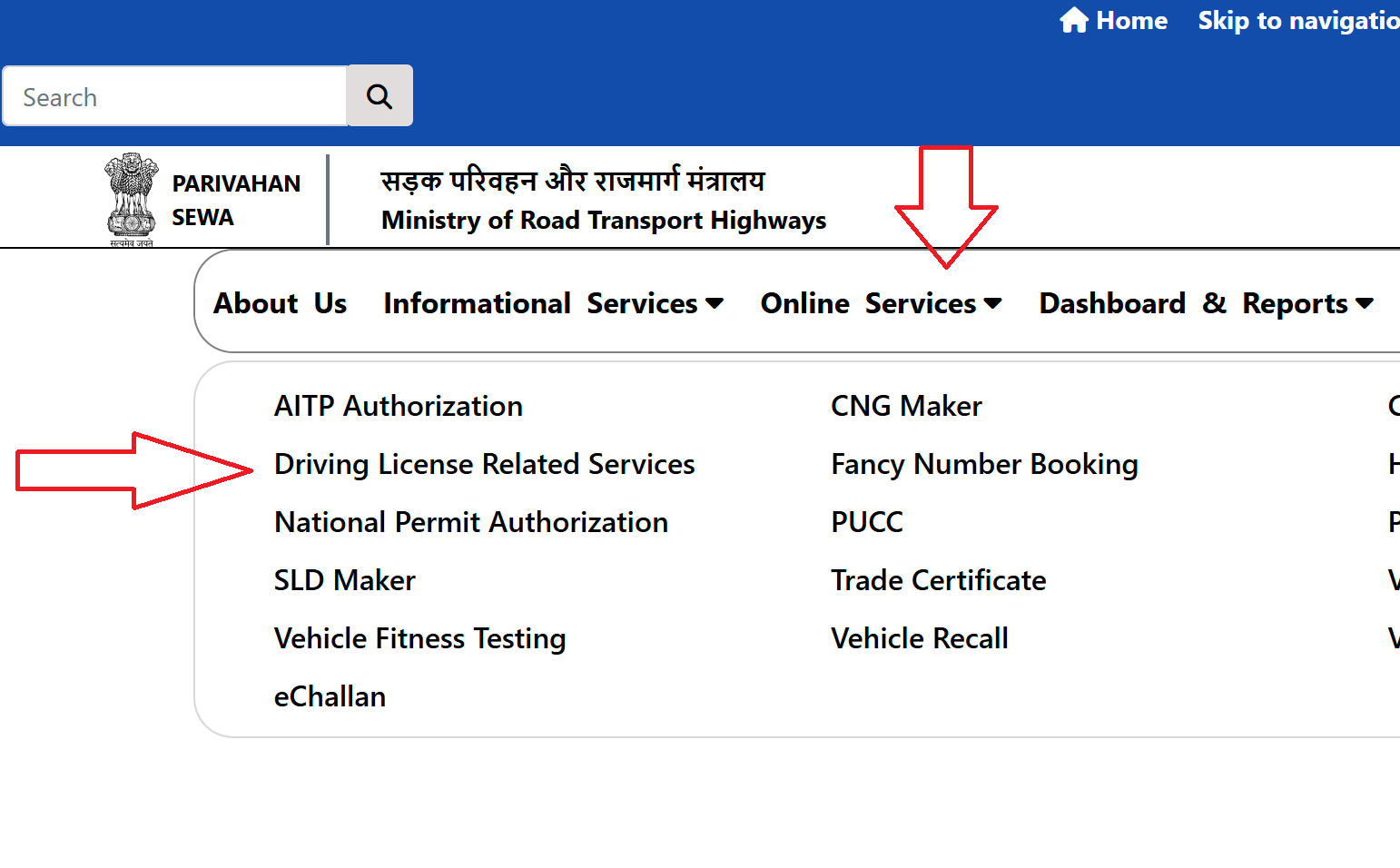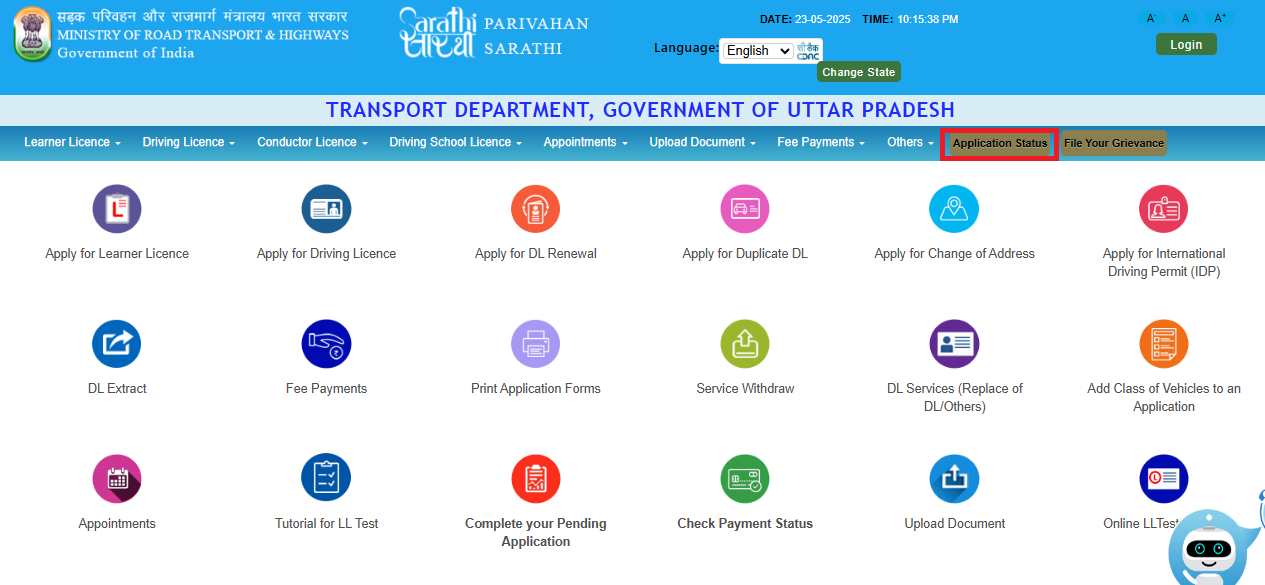A driver's license (DL) is a legal document authorizing individuals to operate vehicles on public roads in India, governed by the Motor Vehicles Act, 1988, and its amendments.
Renewing your driving license is critical to remain compliant with the law, avoid penalties, and ensure road safety by verifying your fitness to drive.
The Ministry of Road Transport and Highways (MoRTH) has streamlined the process with online and contactless options via Aadhaar authentication, while introducing stricter fines for non-compliance.
Process for Driving License Renewal
Online Renewal
The online process is facilitated through the Parivahan Sewa portal, offering convenience and speed.
- Access the Portal: Visit Parivahan Sewa, and click ‘Driving Licence Related Services’ under ‘Online Services’.

- Select Your State: Next, select your state from the drop down menu, for renewing your driving licence.
- Select Renewal Option: Choose ‘Apply for DL Renewal’.

- Enter Details: Provide your Driving Licence number, Date of Birth, and verify with the captcha.

- Fill Application: Complete Form 9, upload Form 1 (self-declaration) or Form 1A (medical certificate if required), proof of address, proof of age, and photographs.
- Pay Fees: Pay the renewal fee (₹200–₹400, depending on the state) and any user charges via net banking, UPI, or card.
- Schedule RTO Appointment: Book a slot for document verification at your nearest RTO.
- Visit RTO: Attend the appointment with original documents for verification.
- Collect DL: Receive your renewed DL within 15 days, either via post or in-person collection, depending on RTO procedures.
Offline Renewal
The offline process involves visiting your local RTO, suitable for those preferring in-person interactions.
- Obtain Forms: Download Form 9, Form 1, and Form 1A from Parivahan Sewa - Forms or collect from the RTO.
- Complete Forms: Fill out the forms accurately, ensuring all details match your original DL.
- Gather Documents: Compile original and photocopies of your DL, proof of address, proof of age, photographs, and medical certificate (if applicable).
- Visit RTO: Submit the documents at your local RTO, along with the NOC if renewing at a different RTO.
- Pay Fees: Pay the renewal fee (₹200–₹400) and any additional charges (e.g., ₹200 for a smart card).
- Verification: The RTO verifies your documents and may conduct a medical or driving test if the license has expired for over a year.
- Collect DL: Receive your renewed DL within 15 days, typically via post or in-person.
Checking Application Status
- Visit the Parivahan Sewa Portal: Open your browser and go to Parivahan Sewa.
- Access Online Services: On the homepage, click ‘Driving Licence Related Services’ under ‘Online Services’.
- Choose Your State: Select your state from the list to proceed to the relevant RTO services.
- Go to Application Status: Click on ‘Application Status’ in the available options.

- Enter Required Details:
- Application Number: Input the application number provided during your DL renewal submission.
- Date of Birth: Provide your date of birth in the format DD-MM-YYYY.
- Lastly, enter the captcha.

- Verify and Submit: Complete the captcha (if prompted) and click ‘Submit’ to view the status.
- View Status: The portal will display the current status of your application, such as "Under Processing," "Approved," or "Dispatched," along with any additional instructions.
Eligibility for DL Renewal
To be eligible for DL renewal in India:
- License Validity: Your DL must not have expired for more than 5 years. If expired beyond 5 years, you must apply for a fresh license, including all tests.
- Physical and Mental Fitness: You must be fit to drive, verified via Form 1 (self-declaration) for private licenses or Form 1A (medical certificate) for commercial licenses or those over 40.
- Age Requirements:
- No maximum age limit exists for DL renewal.
- Validity periods vary by age:
- Under 40: 20 years or until age 50, whichever is earlier.
- Age 40–50: 10 years.
- Above 50: 5 years.
- Commercial Licenses: Require a Driver Refresher Certificate for heavy vehicle operators and a mandatory medical certificate.
Documents Required for DL Renewal
The documents required depend on the type of license (private or commercial) and the applicant’s age. All documents must be submitted in original and photocopy forms, with some states accepting digital copies for online applications.
For Private DL Renewal
For Commercial DL Renewal
Additional Notes
- Aadhaar Card: Optional, but facilitates contactless renewal and serves as both proof of address and age.
- No Objection Certificate (NOC): Required if renewing at an RTO different from the issuing authority.
- Digital Copies: For online applications, scanned copies of documents must be uploaded in PDF or JPEG format, as specified on Parivahan Sewa.
Validity Periods and Renewal Timing
The validity of a DL and the timing of renewal are critical to avoid penalties:
- Private DL Validity:
- Issued for 20 years or until age 50, whichever is earlier.
- Post-50, valid for 5 years.
- Commercial DL Validity: Typically 3 years, requiring more frequent renewals.
- Renewal Window: You can apply for renewal 1 year before or after the expiry date, as per the Motor Vehicles (Amendment) Act, 2019.
- Grace Period: A 30-day window post-expiry allows renewal without penalties. Beyond 30 days, a ₹30 late fee applies, and after 1 year, a driving test may be required.
- Expired Over 5 Years: You must apply for a fresh license, including learner’s license, driving test, and all associated formalities.
Fees
Penalties for Non-Compliance
Driving with an expired DL incurs:
- ₹5,000 fine for driving without a valid license.
- ₹500 fine for not carrying required documents.
- ₹2,000 fine for driving without valid auto insurance.
Benefits of Renewing Your Driver's License
Renewing your DL offers multiple advantages, ensuring legal, financial, and safety benefits:
- Legal Compliance: Driving with an expired license violates Section 177 of the Motor Vehicles Act, 1988, leading to fines up to ₹5,000, imprisonment for up to 3 months, or both.
- Avoid Penalties: Timely renewal within the 30-day grace period post-expiry avoids additional fees (₹1,000) and potential driving tests for licenses expired over a year.
- Road Safety: Renewal ensures you are physically and mentally fit to drive, reducing accident risks, especially for commercial vehicle operators requiring medical certificates.
- Convenience: Online and contactless renewal options via Aadhaar authentication, introduced in 2025, simplify the process, saving time and effort.
- Updated Records: Renewal updates your details (e.g., address, medical status) in the government's database, ensuring accurate identification.
- International Validity: A valid Indian DL is recognized in 15 countries, including the USA, UK, Australia, and Canada, facilitating international travel.
Objectives of DL Renewal
The DL renewal process serves several key objectives:
- Ensure Driver Fitness: Verifies physical and mental capability through self-declarations or medical certificates, particularly for those over 40 or commercial drivers.
- Maintain Legal Compliance: Aligns with the Motor Vehicles Act, 1988, and its 2019 amendments, ensuring only licensed drivers operate vehicles.
- Update Government Records: Keeps the national database current with accurate driver information for regulatory and safety purposes.
- Enhance Road Safety: Reduces risks by ensuring only qualified and fit drivers are on the road, supported by periodic renewals and tests when necessary.